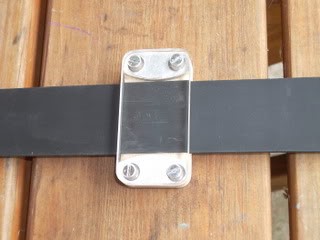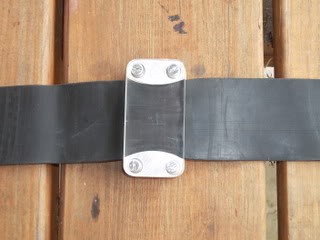Note* sometimes guys will think a belt is too long forgetting that it will become shorter once you put conventional weights on it. Threading the belt through the weights will take up length. No belt at this time is specifically designed for pinch weights. Unlike conventional weights pinch weights don't take up belt length because there's no threading of the belt through and around the weight. For pinch weight users belts are almost always too long.
Pinch weights.


There are two issues here, a belt that is too long leaving a section past the buckle, and/or a belt that needs another hole or two to fit snug against the body. Instead of cutting it off some guys tuck the loose section back under the belt but I think this is a safety issue. I like about 8" of belt past the buckle and just let it dangle there, it's easy to find if I need to drop the belt.
For a belt that's too long, put on the max number of weights, and wear the belt over the thickest wetsuit you plan to use. Mark where you want the belt to end. Cut with a utility knife. To use with pinch weights the tip of the belt needs to be tapered a little width wise, and reduced in thickness. Tapering is done with a utility knife and a steel straight edge, reducing the thickness with a belt sander and something like a block of wood to put even pressure on top of the belt as it comes in contact with the sander.
The concern with cutting into rubber is that a run will be created and eventually the belt will fail/tear at that point. To eliminate this problem, whatever reshaping you're doing must be followed with reducing the rubber past any point where the cut would make way into the rubber material. This reducing can be done with any abrasive tool; belt sander, bench grinder, Dremel with a grinding bit, depending on what you're trying to do specifically. In the case of simply cutting a belt to make it shorter a belt sander is good to round the edges/corners after the cut. In the case of a hole it needs to be made small, so you can then expand it with a small grinding bit.
A Dremel bit.
It's hard to find a tool that will make such a clean hole that it will not weaken the rubber and start a run. I've experimented with a punch that I made out of a pipe with sharpened edges, a wood plug cutter bit for a drill, and a regular drill bit. Now I always make the hole small with whatever tool I have handy, I can even do it with small nail scissors if I have to, the main thing is to expand the hole to its final dimension by grinding. This of course is not an effective method for making many holes, but to make one or two it's the best way I found.
Wood plug cutter.

